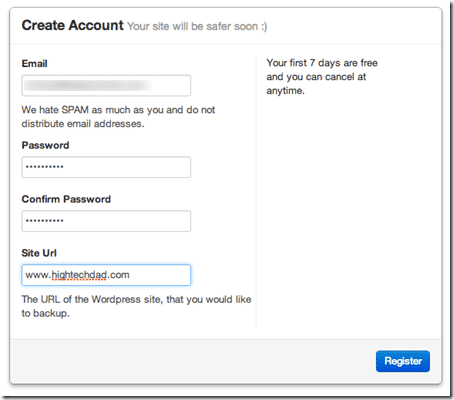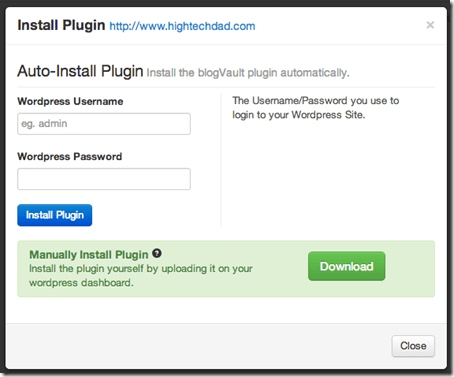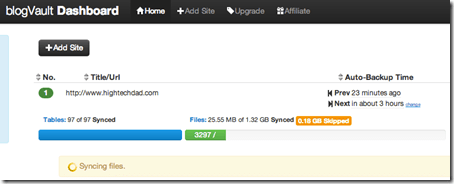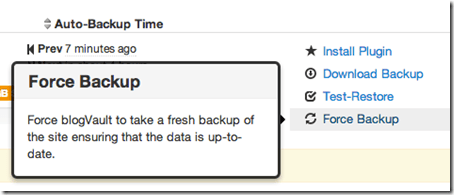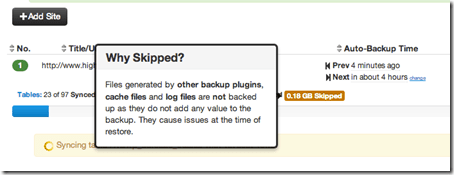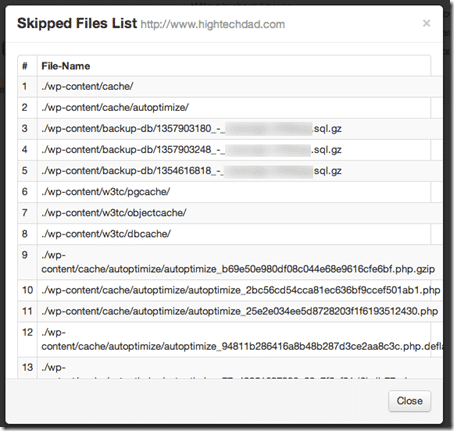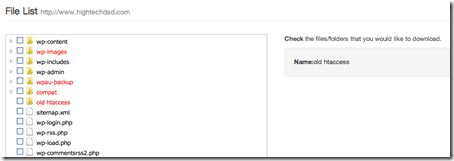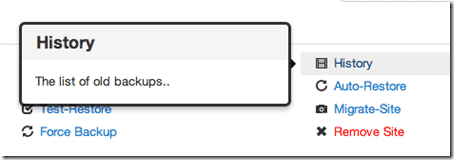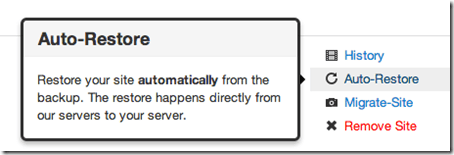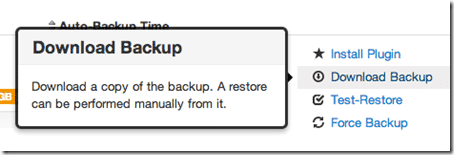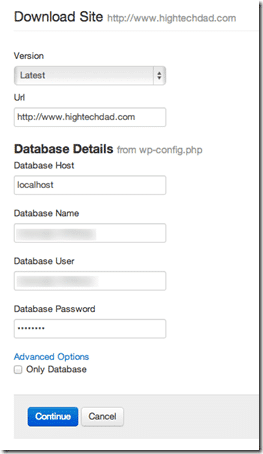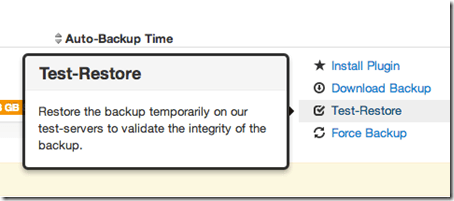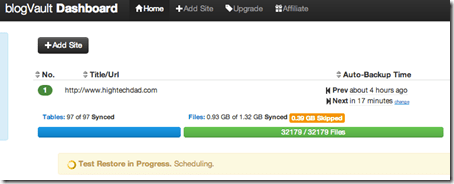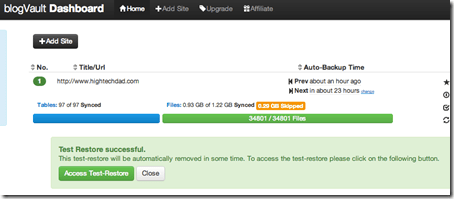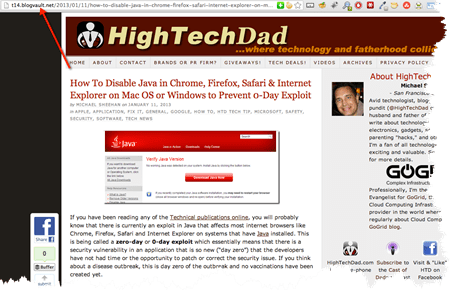If you are a blogger, probably one of the worst things that can happen to you apart from writer’s block is having your blog crash or the server that it is on get corrupted in some way. Technology is imperfect and Murphy’s Law always manages to find us one way or another. If suddenly all of your writing and your site were to disappear, how quickly would you be able to recover? Hours? Days? Weeks? Ever? Seriously, think about this for a second. Unless you are handwriting things or saving copies of each and every blog post, you probably would have a lot of trouble recovering your work. And most of us who manage a WordPress blog tend to highly customize our installs with custom themes and plugins, not to mention have comments on all of our articles. Do you have all of that backed up?
For the past few years, I have been doing manual backups of both my WordPress server files and my WordPress database. There are a few nice database backup plugins that automatically create backups for you, but you still have to download those backups and store them somewhere. That takes time and bandwidth. And since I tended to back up my blog files about 1-3 times a month, I have my computer clogged up with those various versions (which I do delete periodically). Wouldn’t it be nice if there were services that did this for you? There actually are, and I tested out one recently called blogVault (note: affiliate link) and I couldn’t be happier with the results. But, I wasn’t about to put my blog backups in the hands of just anyone. Before I did, I had a bunch of questions that I asked the founder, Akshat Choudhary which you can see below. After that, you can view my walk-through and review of blogVault (which is now currently backing up HighTechDad.com)
Interview with blogVault Founder

Question: How long has blogVault been around?
Answer: It has been almost 3 years now.
Q: Why did you start it?
A: It started as a side project. One of the bloggers that I followed had lost his site to a server crash. I thought that there was an opportunity here.
Q: How many people in the company?
A: There are 3 people in the company.
Q: What is the magic behind the backup functionality?
A: There is hardly any magic. However we follow the very best practice when it comes to backing up a WordPress site. We have a light weight plugin which works in conjunction with our servers to backup a site.
Q: Do you need access to the server? To FTP? To SFTP? Is it plug-in driven?
A: blogVault uses our plugin to do the backup. Once you install the plugin, our server requests the plugin to scan the site and send the data to our servers. After that we only backup the parts that change hence using minimal resources on the site.
Q: What are the advantages vs doing backups yourself?
A: There are numerous advantages. But I think the biggest one being that we think about backups day and night. This focus of ours ensures that you know that your data will be in the most capable hands. You can be assured that no one will forget to backup the data. You can be assured that if the plugin doing the backup gets deactivated, you will be notified.
All of this obviously can be done manually too. However, we have seen that those are mostly cumbersome and not fool-proof using existing free tools.
Q: What are the advantages over Backup Buddy and VaultPress?
A: Backup Buddy just provides the software. After that it is for you to manage. You will need to pay extra for offsite backups and manage the backups on your own. We instead are a complete service. Beyond this there are many other differences we have listed here: http://blogvault.net/compare-us/.
We are very similar to VaultPress in that manner. Like us they too are a complete service. This I believe is the right way to do backups. We however have done many things to provide features which distinguish us from others. We have a unique test-restore feature which lets you restore the backup temporarily on our test servers. This shows that the backups are perfect. We also have a best-in-class migration feature which lets you copy your site to a new server as well as lets you change the URL of the site completely. We do this by intelligently changing the data on your site.
Q: Where do you have the data stored? US? Cloud? (I work at a Cloud Computing company, btw.)
A: We have the data stored on our own servers first. We keep 2 copies of this data on our servers. We further store this in Amazon S3, which keeps 7 copies of it across multiple data centers. This ensures that the data is as safe as it can get.
Q: What type of security do you have in place to prevent unauthorized access?
A: We follow the best security processes out there. We come from strong Computer Science background. We have experience building some of the most robust networking systems. Otherwise we keep our systems updated with the latest patches, etc.
Q: How often to backups take place?
A: We do backups automatically once a day. Also, we have the option to initiate the backup at any time also.
Q: Are they full or incremental backups?
A: Once the initial backup is done, we do only incremental backups. This ensures that minimal load is put on your systems.
Q: What are your plans for the future? New features like security scans of PHP files for exploits?
A: We are focused on backups. We will be adding security features too in the near future. We think that the existing plugins out there which secure WordPress leave much to be desired. We want to build the a better way to do this.
Q: How do you make backups of the database?
A: Our plugin does the backup of the database too.
Q: How quickly can you restore to a new server from a backup? What are the requirements? WordPress already installed?
A: If there is an existing WordPress then the process of migration becomes really simple. This video shows you how easy it is: http://vimeo.com/42434650
The amount of time depends on the size of the site. We do many things to optimize the process though.
Q: Are there any incompatibilities with plugins currently? I use some to backup my DB. Will BlogVault back up those backup DB files as well?
A: We don’t have any compatibility issues as we have kept our plugin to be extremely small. We intelligently try and skip files created by other backup plugins. This again ensures that the strain on the site is reduced.
Q: If we use a caching plugin, do you automatically exclude those directories?
A: We skip the cache files too. This again ensures reduced load. We have also seen that cache files can cause issues during a restore, and hence are best ignored.
A walk-through of how blogVault works
While Akshat’s answers truly helped, I’m a guy who likes to see and understand things first-hand so I decided to get my blog backed up using the blogVault service. Things that I tested were:
- Initial backup
- Incremental backup
- Download backup
- Test-Restore
And I poked around the other features as well to better understand them. First, let’s start with the signup process. When you first sign up, you do have to choose a plan. Plans start as cheap as $9/month for 1 site, pretty darn reasonable if you ask me. Be prepared to pay with PayPal before you proceed any further.
Once you sign up for a plan, you need to install the blogVault plugin. It’s this plugin that does all of the back-up magic for you:
Because I have extra security on my WordPress blog, the “Auto-Install” process did not work for me so I had to manually install the plugin. This was a simple enough process. Just upload and activate the plugin and then blogVault takes over and starts scanning your files.
The dashboard and interface is simple enough to understand. All of your possible actions are clearly laid out with mouse-over explanations.
Syncing starts automatically and you can see what is being synced and when the next and previous backup is/was.
If at any point, you want to not follow the pre-defined schedule, you can force a backup to happen immediately.
There are some files that are not backed up. These are mainly cached files or database backups done by other plugins.
You can see the names of the files that are skipped:
Not only are your files backed up, but also the tables within your WordPress database. You can get the details on that as well:
And you can obviously see the files and folders that are being backed up:
At any point, you can see the history of your backups by clicking the History link:
If at any point, you want to revert back to a previous backup, you can click on “Auto-Restore” and your blog will be restored.
They even have an automated process to Migrate your site to a new server. While I haven’t tried this out, it is supposedly a great way to change domains or servers and they will walk you through the process of moving to a new server.
While you can use the blogVault servers to store all of your 30-day backups, you may wish to periodically download a copy of your blog to your own server. The nice thing is, you can choose to do this at any point and from any backup within the past 30 days.
When you start this process, you can decide on the version as well as if you just want the database or if you want a complete backup with the files as well. You request the backup and blogVault starts the process of extracting the database and compressing it and all of your files as well.
When the backup is complete, you will get an email to download the complete backup. Within the backup is everything that you need to fully restore your blog manually. It’s quite handy actually.
But what if you want to just be sure that your site backups are actually working because you never know if all the DB files and plug-ins and content is truly there unless you test it. Well blogVault has a “Test-Restore” feature that allows you to restore your blog from any backup within the past 30 days.
You simply schedule the Test-Restore and after a few minutes (depending on the size of your site and database), a version of your blog will be hosted (temporarily) on the blogVault servers.
I tested this out and it did take about 15-20 minutes (I can’t remember exactly).
The resulting test-restore mirrored my site perfectly. Plugins worked as expected, content was where is was supposed to be and everything looked fine. Do note though, these test-restore sites are temporary and are typically replaced by other customers’ test-restores in the future. It’s not a permanent URL.
HighTechDad Ratings
There are a couple of things that I hope that blogVault will either create or enhance that will make it even better than it is currently, specifically:
- Backup History – I wish there was a distinction between full and incremental backups. Also, I wish that there was a way to know exactly which files had been changed and consequently backed up.
- Activity Log – I wish that there was a log that would show high-level details on actions that took place (e.g., incremental-backup, download link created with the link, test-restore created with the restore link)
From my perspective, blogVault is offering a very needed service to self-hosted WordPress bloggers. Having backups of your data is pretty critical, whether you do it manually or via an automated, paid-for service like blogVault. And while I haven’t tested other WordPress backup services to compare, after digging and asking questions about blogVault, I felt that their service was quite reasonably priced based on the services that they offer.
Thus far, I’m quite pleased and I hope I never have to use blogVault in an emergency because that will have meant that my server or blog had crashed or become corrupted. But having tested out their service thus far on a manual basis, I’m fairly confident that I would have my data, content and settings quickly and safely stored.
HTD says: If you have a WordPress, self-hosted blog, make your backup and recovery process easy with blogVault!



